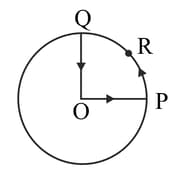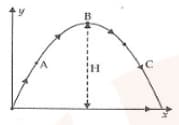A particle slides down a frictionless parabolic track starting from rest at point as in figure. Point is at the vertex of parabola and point is at a height less than that of point . After , the particle moves freely in air as a projectile. If the particle reaches highest point at , then

.


Important Questions on Motion in a Plane
A cyclist starts from centre of a circular park of radius and moves along the path OPRQO as shown in the figure. If he maintains the constant speed of ,what is his acceleration at point in magnitude and direction?

.
 A particle is projected in the air at some angle to the horizontal, moves along the parabola as shown in the figure, where and indicate horizontal and vertical directions respectively. Show in the diagram, direction of velocity and acceleration at points and .
A particle is projected in the air at some angle to the horizontal, moves along the parabola as shown in the figure, where and indicate horizontal and vertical directions respectively. Show in the diagram, direction of velocity and acceleration at points and .

